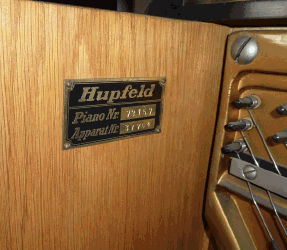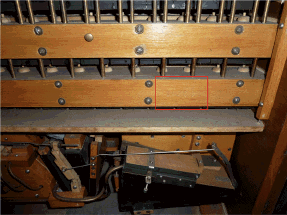Year of production of your piano
All well-known manufacturers assigned serial numbers and internal production numbers to the pianos during the production process and usually noted these in several places on the instrument. Depending on the manufacturer, many details were noted in the so-called production and sales books: year of manufacture (usually at the beginning of the production of the rests), the design, the employees involved, the date of delivery, the first buyer and usually also the price achieved. Several decades, wars and company closures later, very few of these complete records have survived. Fortunately, Steinway, Bechstein, Ibach, Bösendorfer, Pleyel and others still have a lot of original information. In some cases, it is also possible to request research or proof of manufacture for a fee.

WHAT IF I CAN'T FIND ANYTHING FOR MY PIANO?
It is not always easy to find specific information, especially with less well-known manufacturers and, for example, with built-in pianos, where only experts can tell which piano was installed. In addition, clear serial numbers are sometimes missing because they have been removed during the production process or during subsequent renovations. However, the certificate required since January 19, 2022 for all pianos with ivory key pads requires a clear determination of age and condition. If you would like to know the age of your piano or further details and cannot find what you are looking for, bieten wir eine kostenpflichtige Recherche an – dann auch zusammen mit weiteren Informationen, sofern uns diese Vorliegen.
HOW CAN I FIND OUT THE VALUE OF MY PIANO?
Please also read our post 'What's the value of my piano''. If you would like a statement on the value of your piano, we offer a fee-based remote assessment based on the information and photos provided - On request and for an additional charge, we can also send a master piano maker to take a closer look at the instrument on site. You can also contact any local piano maker for an on-site inspection and assessment of the piano.
WHERE CAN I FIND THE SERIAL NUMBER FOR PIANOS?
The serial number is usually easy to find without major disassembly of the piano. First, open the top cover of the piano, the serial number is usually located on the cast iron plate, on the inside of the case on the right or left or on the soundboard under the strings. Here are some photo examples of where the serial number can be found on the instrument. Sometimes - especially if the instrument has not been properly restored - the serial number has been removed and can only be found very hidden (on the keyboard frame, on individual components of the piano, etc.). The serial number of the action of well-known manufacturers such as Renner or Schwander can also be used to determine the period of manufacture.
You can open the top front cover by folding open the top cover and then releasing the catch on the inside on the right and left by simply turning the small pieces of wood attached there. You can then remove the upper front cover forwards. If lights are attached, make sure that they do not hit the cover and cause scratches when removing and installing them.
You can remove the lower lid by either bending the small wooden bar in the middle upwards - or by turning the small wooden bars on the right and left so that the lid can be removed freely towards the front. When transporting pianos, it is better to remove this lower lid or secure it, as it is otherwise likely to fall off if shaken and then become scratched.
WHERE CAN I FIND THE SERIAL NUMBER FOR PIANOLAS?
The most reliable way to determine the age of pianolas is to check the piano serial number. In addition, there are further serial numbers of the manufacturers of these components on the self-playing mechanism. It is also possible to date them, but less precisely, as we have no information from the manufacturers and work with our own records. The following photos show examples of the position and display of serial numbers on pianolas from different manufacturers.
You can open the top front cover by folding open the top cover and then releasing the catch on the inside on the right and left by simply turning the small pieces of wood attached there. You can then remove the upper front cover forwards. If lights are attached, make sure that they do not hit the cover and cause scratches when removing and installing them.
You can remove the lower lid by either bending the small wooden bar in the middle upwards - or by turning the small wooden bars on the right and left so that the lid can be removed freely towards the front. When transporting pianos, it is better to remove this lower lid or secure it, as it is otherwise likely to fall off if shaken and then become scratched.
The Welte-Mignon Vorsetzer has two serial numbers - one stamped into the wood at the top right in front of the wind motor.
...and a serial number on the back, usually stamped into the wood at the top right.
Welte-Mignon Kabinett also has two serial numbers, one on the back of the case, usually at the top right...
...and the piano serial number hidden in the interior on the left below the action on the soundboard (with Feurich acoustics).
On Welte grand pianos there is usually another serial number below the console on the right...
Welte pianos/grands have a serial number on the windchest (e.g. FEU for Feurich, ST for Steinway, etc.) and a number...
Hupfeld instruments have two serial numbers on a metal plate - a piano number and an instrument number.
On Hupfeld Phonola installations, the Hupfeld serial number can also be found on the upper installation, usually on the edge of the wind motor...
Hupfeld-DEA starters have a serial number in the lower interior on the windchest.
The serial number of Hupfeld Phonola pre-setters is printed on the edge of the pedal rod holder on the back of the pre-setter.















